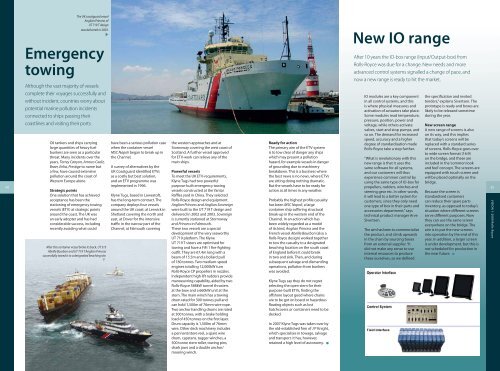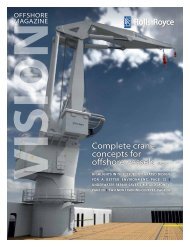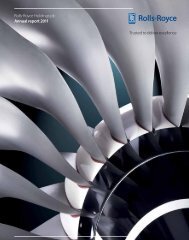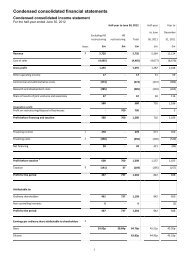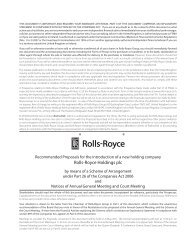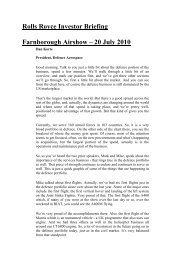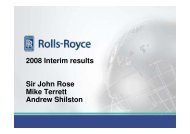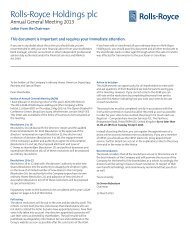Vision 2009 - Rolls-Royce
Vision 2009 - Rolls-Royce
Vision 2009 - Rolls-Royce
You also want an ePaper? Increase the reach of your titles
YUMPU automatically turns print PDFs into web optimized ePapers that Google loves.
24<br />
VISION 1-<strong>2009</strong>. <strong>Rolls</strong>-<strong>Royce</strong><br />
The UK coastguard vessel<br />
Anglian Princess of<br />
UT 719 T design<br />
was delivered in 2003.<br />
A<br />
Emergency<br />
towing<br />
Although the vast majority of vessels<br />
complete their voyages successfully and<br />
without incident, countries worry about<br />
potential marine pollution incidents<br />
connected to ships passing their<br />
coastlines and visiting their ports.<br />
Oil tankers and ships carrying<br />
large quantities of heavy fuel<br />
bunkers are seen as a particular<br />
threat. Many incidents over the<br />
years, Torrey Canyon, Amoco Cadiz,<br />
Braer, Erika, Prestige to name but<br />
a few, have caused extensive<br />
pollution around the coast of<br />
Western Europe alone.<br />
Strategic points<br />
One solution that has achieved<br />
acceptance has been the<br />
stationing of emergency towing<br />
vessels (ETV) at strategic points<br />
around the coast. The UK was<br />
an early adopter and has had<br />
considerable success, including<br />
recently avoiding what could<br />
After this container vessel broke its back, UT 515<br />
Abeille Bourbon and UT 719 T Anglian Princess<br />
successfully towed it to a designated beaching site.<br />
D .<br />
have been a serious pollution case<br />
when the container vessel<br />
MSC Napoli began to break up in<br />
the Channel.<br />
A survey of alternatives by the<br />
UK Coastguard identified ETVs<br />
as a costly but best solution,<br />
and an ETV programme was<br />
implemented in 1996.<br />
Klyne Tugs, based in Lowestoft,<br />
has the long-term contract. The<br />
company deploys four vessels<br />
around the UK coast: at Lerwick in<br />
Shetland covering the north and<br />
east, at Dover for the intensive<br />
traffic in the narrow part of the<br />
Channel, at Falmouth covering<br />
the western approaches and at<br />
Stornoway covering the west coast of<br />
Scotland. A further vessel approved<br />
for ETV-work can relieve any of the<br />
main ships.<br />
Powerful vessels<br />
To meet the UK ETV-requirements,<br />
Klyne Tugs had two powerful<br />
purpose-built emergency towing<br />
vessels constructed at the Yantai<br />
Raffles yard in China. They selected<br />
<strong>Rolls</strong>-<strong>Royce</strong> design and equipment.<br />
Anglian Princess and Anglian Sovereign<br />
were built to the UT 719 T design and<br />
delivered in 2002 and 2003. Sovereign<br />
is currently stationed at Stornoway<br />
and Princess in Falmouth.<br />
These two vessels are a special<br />
development of the very seaworthy<br />
UT 719 platform. The Klyne<br />
UT 719 T sisters are optimised for<br />
towing and have a FiFi 1 fire-fighting<br />
outfit. They are 67.4m long with a<br />
beam of 15.5m and a bollard pull<br />
of 180 tonnes. Two medium-speed<br />
engines totalling 12,000kW turn<br />
<strong>Rolls</strong>-<strong>Royce</strong> CP propellers in nozzles.<br />
Independent high lift rudders provide<br />
manoeuvring capability, aided by two<br />
<strong>Rolls</strong>-<strong>Royce</strong> 588kW tunnel thrusters<br />
at the bow and a 660kW unit at the<br />
stern. The main winch has a towing<br />
drum rated for 300 tonnes pull and<br />
can hold 1,500m of 76mm wire rope.<br />
Two anchor handling drums are rated<br />
at 300 tonnes, with a brake holding<br />
load of 450 tonnes on the first layer.<br />
Drum capacity is 1,500m of 76mm<br />
wire. Other deck machinery includes<br />
a pennant/store reel, a spare wire<br />
drum, capstans, tugger winches, a<br />
500 tonne stern roller, towing pins,<br />
shark jaws and a double anchor/<br />
mooring winch.<br />
Ready for action<br />
The primary aim of the ETV-system<br />
is to tow clear of danger any ships<br />
which may present a pollution<br />
hazard, for example vessels in danger<br />
of grounding due to machinery<br />
breakdown. This is a business where<br />
the best news is no news, where ETVs<br />
are sitting doing nothing dramatic.<br />
But the vessels have to be ready for<br />
action at all times in any weather.<br />
Probably the highest profile casualty<br />
has been MSC Napoli, a large<br />
container ship suffering structural<br />
break-up in the western end of the<br />
Channel. In an action which has<br />
been widely regarded as a model<br />
of its kind, Anglian Princess and the<br />
French vessel Abeille Bourbon (also a<br />
<strong>Rolls</strong>-<strong>Royce</strong> design) worked together<br />
to tow the casualty to a designated<br />
beaching location on the south coast<br />
of England before it could break<br />
in two and sink. Then, and during<br />
subsequent salvage and dismantling<br />
operations, pollution from bunkers<br />
was avoided.<br />
Klyne Tugs say they do not regret<br />
selecting the open stern for their<br />
purpose-built ETVs, finding the<br />
offshore layout good where chains<br />
are to be got on board or hazardous<br />
floating objects such as lost<br />
hatchcovers or containers need to be<br />
decked.<br />
In 2007 Klyne Tugs was taken over by<br />
the old-established firm of J P Knight,<br />
which specialises in towage, salvage<br />
and transport. It has, however,<br />
retained a high level of autonomy. A<br />
New IO range<br />
After 10 years the IO-box range (Input/Output-box) from<br />
<strong>Rolls</strong>-<strong>Royce</strong> was due for a change. New needs and more<br />
advanced control systems signalled a change of pace, and<br />
now a new range is ready to hit the market.<br />
IO modules are a key component<br />
in all control systems, and this<br />
is where physical measures and<br />
activation of actuators take place.<br />
Some modules read temperature,<br />
pressure, position, power and<br />
voltage, while others activate<br />
valves, start and stop pumps, and<br />
so on. The demand for increased<br />
speed, accuracy and a higher<br />
degree of standardisation made<br />
<strong>Rolls</strong>-<strong>Royce</strong> take a step further.<br />
“What is revolutionary with this<br />
new range is that it uses the<br />
same software for all systems,<br />
and our customers will thus<br />
experience common control by<br />
using the same type of IO-box for<br />
propellers, rudders, winches and<br />
steering gear etc. In other words,<br />
it will lead to a better system for<br />
customers, since they only need<br />
one type of box in their parts and<br />
accessories department,” says<br />
technical product manager Arve<br />
Sivertsen.<br />
The aim has been to commer cialise<br />
the product, and climb upwards<br />
in the chain by sourcing boxes<br />
from an external supplier. “It<br />
did not make any sense to use<br />
internal resources to produce<br />
these ourselves, so we defined<br />
the specification and invited<br />
tenders,” explains Sivertsen. The<br />
prototype is ready and boxes are<br />
likely to be released sometime<br />
during the year.<br />
New screen range<br />
A new range of screens is also<br />
on its way, and this implies<br />
that today’s screens will be<br />
replaced with a standard series<br />
of screens. <strong>Rolls</strong>-<strong>Royce</strong> goes over<br />
to wide screen format (16:9)<br />
on the bridge, and these are<br />
included in the ‘common look<br />
and feel’ concept. The screens are<br />
equipped with touch screen and<br />
will be placed optimally on the<br />
bridge.<br />
Because the screen is<br />
standardised customers<br />
can reduce their spare parts<br />
inventory, as opposed to today’s<br />
situation where different screens<br />
serve different purposes. Now<br />
they can use the same screen<br />
everywhere on the bridge. The<br />
aim is to put the new screens<br />
into operation by the end of this<br />
year. In addition, a larger screen<br />
is under development, but this is<br />
not scheduled for production in<br />
the near future. A<br />
25<br />
VISION 1-<strong>2009</strong> <strong>Rolls</strong>-<strong>Royce</strong>


